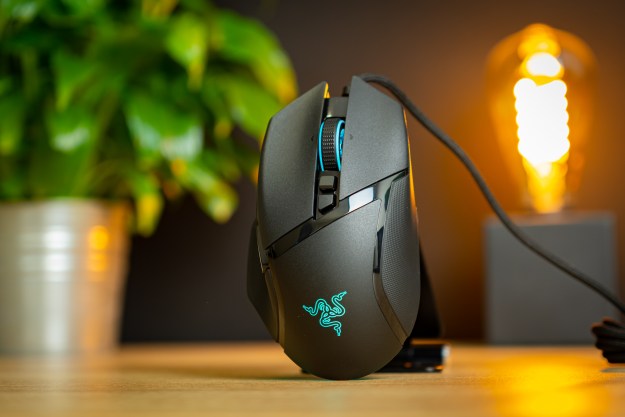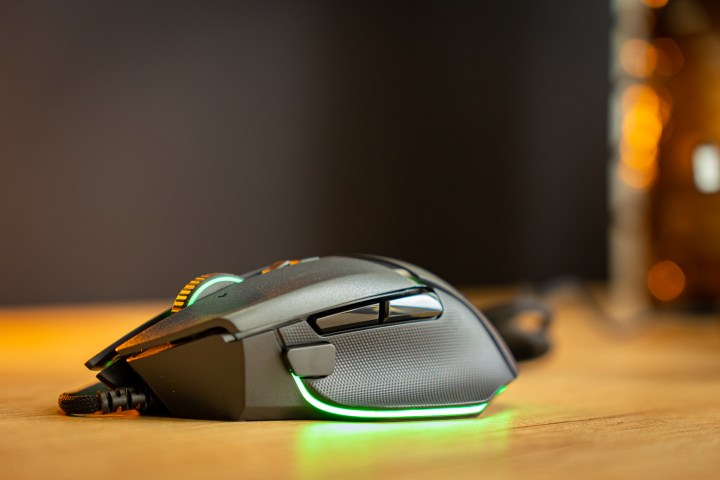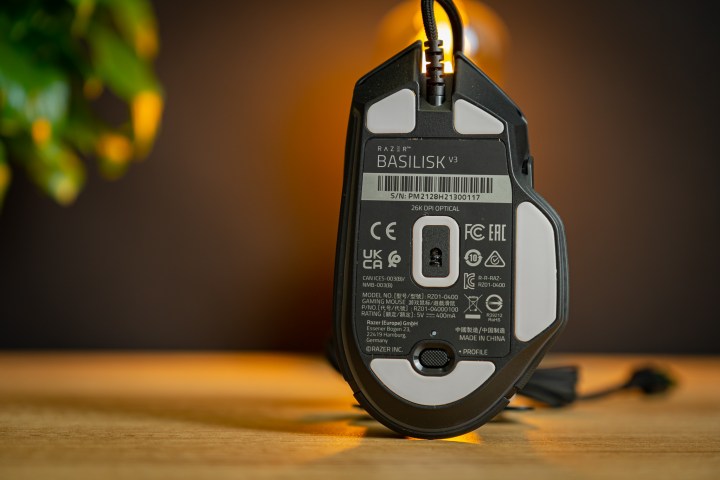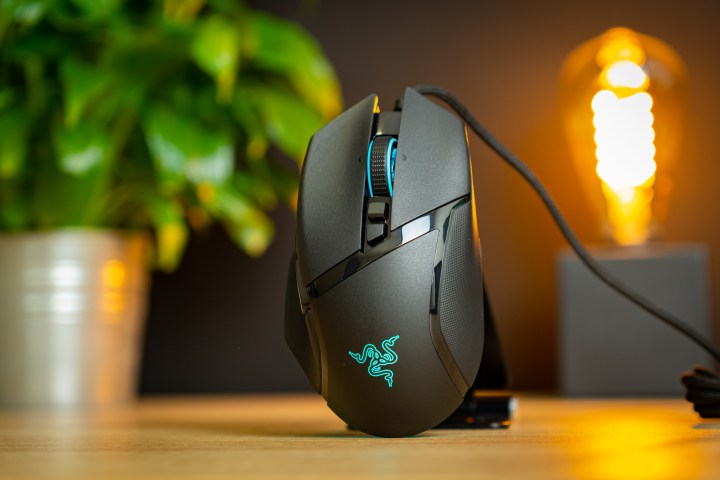
- Tons of RGB
- 10+1 programmable buttons
- Optical switches
- Great 26K sensor
- Quality cable
- Heavy for a wired mouse
- More attractive competition
Razer makes a lot of gaming mice, and the Basilisk is among its more admired offerings. Today, the company is coming out with a new, updated variant: The Basilisk V3. Razer has slightly updated its design, swapped in a new sensor and free-spinning scroll wheel, and even sprinkled in some more RGB for good measure.
This isn’t the wireless Basilisk Ultra – the Basilisk V3 comes with a traditional cable – but that does mean it’s priced at just $70. The third iteration of the Razer Basilisk isn’t revolutionary, but the upgrades mean this standby is still one of the best wired mice you can buy.
Design
Starting with the mouse’s design, Razer largely kept the mouse’s shape identical to what it used to be – a mildly ergonomic right-handed gaming mouse built to be great for palm and claw grips. At a medium size, unless you have especially small hands, chances are you will be leaning toward a claw grip with this pointer, especially in-game.
Weighing in at 101 grams, the mouse is a little weighty by today’s standards, especially for a wired mouse. The benefit here is that Razer hasn’t shaved the shell to be ultralight, so the mouse does inspire confidence when it comes to build quality. The center is made of textured plastic with a few glossy elements, whereas the left thumb rest and grip on the right are made from a nice, grippy rubber material.
Previously, the Razer logo and scroll wheel were lit as they are here, but the V3 adds a strip of RGB along the majority of the mouse’s lower perimeter, creating a sort of underglow effect that does look quite dashing.
And then there’s the cable, which can be the elephant in the room for many gaming mice today. That’s not the case here, as Razer has done a nice job with it. Companies have been developing their wireless tech tirelessly over the last few years in order to get rid of the cable, but that doesn’t mean cable developments have stood still: The Basilisk V3 might have a thick, pretty braided cable, but it’s extremely light and oh-so flexible, so in terms of feel, you barely notice its presence. Yes, you see it, but it doesn’t look so bad.
The Razer’s main competition is Logitech’s G502 Hero, a mouse with an almost identical design and feature set. At least as far as the shape is concerned, although the dimensions are nearly identical, the G502 is slightly fuller and has more squared-off edges – it’s not as round as the Basilisk V3, and I prefer it. But there’s very little in it, and unless you have the two side by side, you won’t be able to tell which you like more.
Buttons and sensors
Powering the Basilisk V3 is Razer’s 26K DPI Focus+ sensor, and although there is no situation in which I can recommend gaming at this kind of DPI, it is a good sensor. It’s responsive and tracks accurately without any acceleration. Tracking is said to be accurate at up to 650 IPS, and although I haven’t tested this figure, I personally play at a low DPI, and the V3 has been more than capable of keeping up with my fast flicks across great distances.
The Basilisk V3 is a mouse that is fast enough to always keep up with you, the gamer.
Meanwhile, under the main left and right buttons, Razer implemented its second-generation optical mouse switches, which is yet another factor contributing to the Basilisk V3’s gaming pedigree. Although traditional buttons are plenty fast, the benefit of an optical switch is that the mouse’s controller doesn’t need to account for debounce, leading to faster actuations — as soon as the button is pressed and the optical signal is interrupted, the actuation signal is sent to the PC.
Pair that with the mouse’s 1000Hz polling rate, and you can rest assured that whatever it is that’s leading to your death in-game, it isn’t the mouse.
Other features
But the fun of the Basilisk V3 doesn’t end there. One of the main upgrades, and one I personally hugely appreciate, is the scroll wheel. It now spins freely at the press of a button, making it a breeze to navigate through large texts and websites. The catch is that the adjustable resistance from the V2 mouse is gone, but I would say this is a justified trade-off.
The runner-up highlight of the Basilisk V3 is the Hypershift button – a key directly ahead of your thumb that briefly lowers the DPI when pressed. Imagine this as a sort of sniping mode, and pressing it lets you aim with more accuracy to line up your shot. The button is reshaped from the V2 mouse to a more subtle implementation.
Meanwhile, all the mouse’s buttons are fully customizable, and there is a button at the bottom to switch through different profiles. This last feature is great for when you play multiple types of games and require totally different mouse assignments. For example, you may need a low DPI profile for FPS shooters that has certain buttons assigned to throw grenades or switch to your melee weapon, but then want to switch to high DPI and other button assignments for strategy games. That’s all easy to configure in Razer’s software, and the button at the bottom makes switching between them a breeze.
Gaming performance
To test the Razer Basilisk V3’s gaming performance, I jumped straight into Insurgency Sandstorm, as this is a realistic first-person shooter game that’s ideal for testing a gaming mouse. With my mates, we play this game as a team of humans versus the highest bot count possible — a proper challenge — and the Basilisk V3 more than kept up with my gameplay.
My usual go-to mouse is the Logitech G Pro X Superlight, and although the Basilisk V3 didn’t quite match up to it, it wasn’t far off either. Any new mouse takes time to get used to, and the Superlight is both much lighter and wireless – but it’s also twice as expensive and is about as feature-rich as a piece of cardboard. This makes a strong case for the Basilisk V3.
Our take
Razer’s Basilisk V3 may not be a huge update, but its reshaped Hypershift button, free-spinning scroll wheel, updated sensor, and added dash of RGB do keep it interesting and certainly worth considering.
It’s not a mouse worth getting hugely excited for, but it makes for a good jack-of-all-trades and a fine option for both gaming and general desktop use thanks to its scroll wheel and semi-ergonomic shape.
Are there any alternatives?
The main competitor is Logitech’s G502 Hero, which has a very similar shape. Though it doesn’t pack as much RGB or optical switches, it has two more programmable buttons, tunable weights, and a more modern, angular design. It’s often also often discounted to just $50, altogether making it a more compelling option and among the Best Gaming Mice.
Meanwhile, Corsair’s Nightsword RGB may be a better fit if you have a Corsair-focused setup. It also boasts a ton of RGB and a similar feature set.
How long will it last?
Under normal circumstances, the Basilisk V3 should last a minimum of about five years. Razer’s warranty covers it for two.
Should I buy it?
Yes. If you’re in the market for a new gaming mouse, looking for a good jack-of-all-trades, and want something to match a Razer setup, then the Basilisk V3 is an excellent purchase, though it may be worth waiting for it to be discounted to $50.
Editors' Recommendations
- Razer, somehow, made a mouse pad exciting
- YouTuber claims that this ugly 3D-printed mouse is actually the best for gaming
- AMD 7000X3D V-Cache CPUs could challenge Intel at CES 2023
- AMD’s revolutionary 3D V-Cache chip could launch very soon
- Lenovo IdeaPad Gaming 3 hands-on review: Gaming on the cheap










